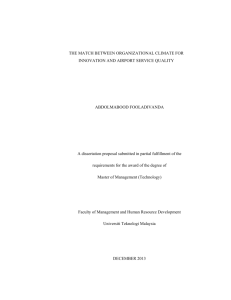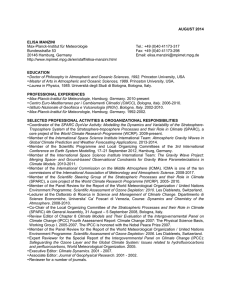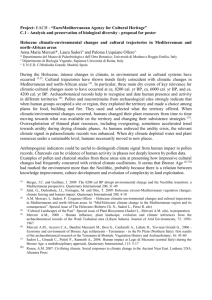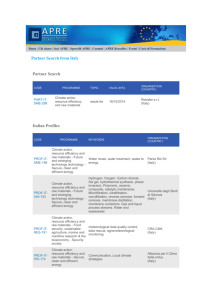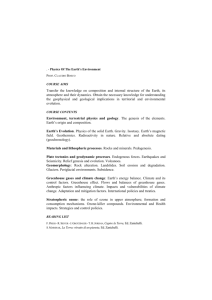View/Open - Universitas Hasanuddin
advertisement
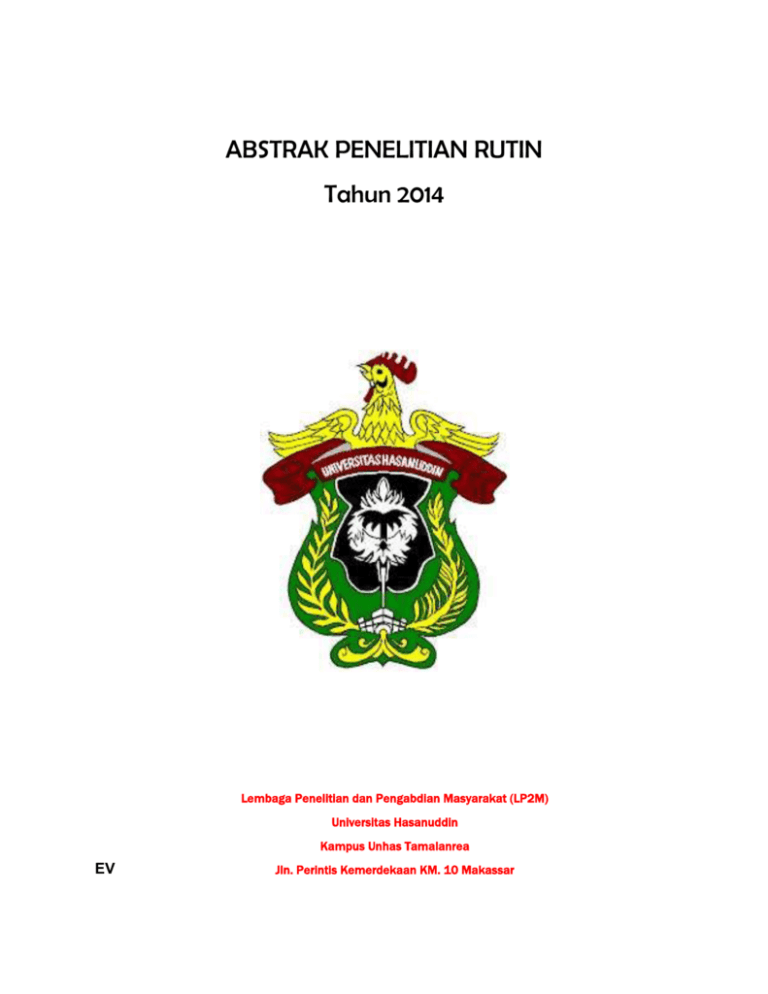
ABSTRAK PENELITIAN RUTIN Tahun 2014 Lembaga Penelitian dan Pengabdian Masyarakat (LP2M) Universitas Hasanuddin Kampus Unhas Tamalanrea EV Jln. Perintis Kemerdekaan KM. 10 Makassar Telp. : (0411) 587032, , 582500, 588888 Fax. (0411) 587032, 584024 Website : http://www.unhas.ac.id/lppm email : lp2m@unhas.ac.id ALUASI MODEL CROPWAT/CROPSYST DAN SIMULASI TANAMAN KEDELAI DIBAWAH KONDISI PERUBAHAN IKLIM DI SULAWESI SELATAN. Kaimuddin, Hernusye Husni, Rafiuddin dan Suardy Mandung ABSTRAK Sektor yang paling rentan terhadap dampak perubahan iklim ekstrim ini ialah sektor pertanian, khususnya ekosistem kedelai. Sedangkan di Indonesia penelitian tentang perubahan iklim dan besar kecilnya dampak keragaman dan perubahan iklim pada suatu sistem yang bergantung pada sensitivitas, kemampuan adaptif, resiliensi dan kerentanan dari sistem tersebut terhadap keragaman dan perubahan iklim, masih sangat terbatas, sementara informasi ini sangat diperlukan untuk membantu berbagai sektor, khususnya sektor pertanian, dalam meningkatkan kemampuan dalam mengelola risiko iklim. Menurunnya luas panen dan produktivitas kedelai karena adanya kejadian anomali iklim (kekeringan dan kebanjiran) dan perubahan iklim. Untuk menilai dampak perubahan iklim diperlukan perkiraan bagaimana iklim itu berubah pada tingkat lokal dan regional, serta bagaimana perubahan tersebut mempengaruhi ekosistem dan kehidupan manusia. Salah satunya menggunakan model tanaman (crop modelling) dan integrasi model tanaman dengan general circulation models (GCMs). Penelitianpenelitian tentang kerentanan pada ekosistem kedelai dan pemanfaatan pemodelan tanaman (crop modeling) untuk menilai sistem adaptasi dan pengelolaannya pada ekosisten kedelai secara terintegrasi belum dilakukan. Pada penelitian ini akan digunakan model CropSyst sebagai alat untuk melihat dampak perubahan iklim terhadap ekosistem yang berbasis kedelai. Tujuan dari penelitian adalah untuk: (a) membangkitkan nilai Thermal Time dan Fenologi tanaman kedelai, (b) memverifikasi dan memvalidasi model Cropwat/CropSyst dari data hasil percobaan tanaman kedelai, (c) menganalisis sifat hujan ekstrim pada sentra produksi kedelai di Sulawesi Selatan, (d) menganalisis tingkat kerentanan petani terhadap perubahan iklim, dan (d) untuk mempelajari dan menganalisis dampak perubahan iklim terhadap tingkat produktivitas tanaman kedeleai. Luaran penelitian ini akan diperoleh nilai-nilai thermal time dan fenologi tanaman kedelai yang bermanfaat sebagai input/masukan terhadap model tanaman (crop models, Cropwat/CropSyst). Juga menghasilkan model tanaman kedelai yang telah di kalibrasi dan di validasi. Penelitian ini dilaksanakan selama dua tahun, dimana tahun I terbagi atas tiga tahap yaitu (1) survai lapang di daerah sentra produksi kedelai di Kabupaten Maros, Barru, Wajo, dan Soppeng dengan tujuan mengumpulkan data-data tentang lokasi penelitian yang akan dimasukkan kedalam program, (2) rangkaian percobaan yang dilaksanakan di screen house dan di Kabupaten Jeneponto. (3) pengolahan data (desk studi) dengan mengumpulkan data-data hasil survai lapang dan hasil percobaan lapangan. Pada tahun kedua dilaksanakan penelitian dalam bentuk aplikasi model CropSyst yang telah di kalibrasi dan divalidasi pada tahun pertama pada berbagai level percobaan. Hasil penelitian menunjukkan bahwa Fenologi tanaman kedelai (jumlah hari yang dibutuhkan untuk mencapai fase tertentu) berbeda antara percobaan Screen House dengan percobaan di Kabupaten Jeneponto. Thermal time yang dibutuhkan untuk setiap fase juga berbeda. Rendahnya produktivitas yang diperoleh pada percobaan lapangan (0,342 t ha-1) disebabkan tanaman mengalami cekaman kekeringan dan juga intensitas radiasi yang tinggi dan sejalan dengan hasil yang diperoleh pada luaran CropSyst (0,445 t ha-1). Hasil kalibrasi model cropSyst terhadap parameter biomassa tanaman dan ILD menunjukkan bahwa luaran model menghasilkan biomassa sebesar 6.65 t ha-1 dibandingkan dengan hasil yang diamati sebesar 6.71 t ha-1. Nilai RMSE adalah 8% dari rata-rata hasil yang diamati. Demikian pula dengan ILD, luaran model menghasilkan nilai sebesar 2.16 cm2 cm-2 sedangkan hasil pengamatan menunjukkan nilai sebesar 2,12 cm2 cm-2. Hasil ini menunjukkan bahwa model tersebut akurat dan dapat merespon terhadap kondisi cuaca dan air di lokasi percobaan.. Kata kunci: kedelai, perubahan iklim, Cropwat, CropSyst, Fenologi Tanaman, Thermal Time. ABSTRACT Evaluation of Crowat/Cropsyst Models and Simulation of Soybean crop under conditions of climate change in South Sulawesi (Kaimuddin, Hernusye Husni, Rafiuddin and Suardy Mandung) The most vulnerable sector to this extreme climate change impacts is the agricultural sector, particularly the soybean ecosystem. Recently in Indonesia, researches on climate change and the size of the climate variability impact and changes to a system that relies on the sensitivity, adaptive capacity, resilience and vulnerability of these systems to climate variability and change, are still very limited, while this information is necessary to assist the various sectors, particularly the agricultural sector, in improving the ability to manage climate risks. Decline in harvested area and productivity of soybean are due to the occurrence of climate anomalies (droughts and floods) and climate changes. In order to assess the impact of the climate changes it is necessary to estimates how the climate changes at local and regional levels, as well as how these changes affect the ecosystem and human life. One way to estimate is by using the model plant (crop modeling) and the integration of the plant model into a general circulation models (GCMs). Studies on susceptibility of soybean ecosystem and utilization of plant model (crop modeling) to assess the adaptation and management of the system in an integrated soybean ecosystem have not been made. This research will use model CropSyst as a tool to assess the impact of climate change on soybean-based ecosystem. The aims of the study were to: (a) raise the value of Thermal Time and soybean crop phenology, (b) verify and validate the model CropWat / CropSyst using an experimental data of soybean plants, (c) analyze the properties of extreme rainfall on soybean production center in South Sulawesi, (d) analyze the vulnerability of farmers to climate change, and (d) to study and analyze the impact of climate change on soybean crop productivity levels. Outcomes of this study will be values of thermal time and phenology of soybean plants that are useful as inputs to the model plant (crop models, CropWat / CropSyst). In addition, a calibrated and validated model for soybean plant will be obtained. This study was conducted over two years, of which the first year is divided into three stages: (1) soil survey in soybean production areas in Maros, Barru Wajo and Soppeng with the aim of collecting data on the study site to be incorporated into the program, (2) a series of experiments were conducted in the screen house and in the field in Jeneponto. (3) data processing (desk study) to collect the data of the field survey and the results of field experiments. In the second year of research carried out in the application form of CropSyst models that have been calibrated and validated at the various levels of experiments carried out in the first year. The results showed that the soybean crop phenology (the number of days required to reach a certain phase) differed between trials conducted in the Screen House and in the field at Jeneponto. Thermal time required for each phase is also different. Low productivity obtained in field trials (0.342 t ha-1) caused crops suffer drought stress and high radiation intensity which is in accordance with the results obtained on the outpit of CropSyst (0.445 t ha-1). The results of the model calibration parameters of CropSyst for plant biomass and LAI showed that output the model produces biomass of 6.65 t ha-1 compared to observed results of 6.71 t ha-1. RMSE value was 8% of the average observed outcomes. Similarly with ILD, outputs of the model showed a value of 2:16 cm2 cm-2 while observations showed the value of 2.12 cm2 cm-2. These results indicate that the model is accurate and can respond to the weather and water conditions at the site of the experiment. Keywords: soybean, climate change, CropWat, CropSyst, Plant phenology, Thermal Time.
